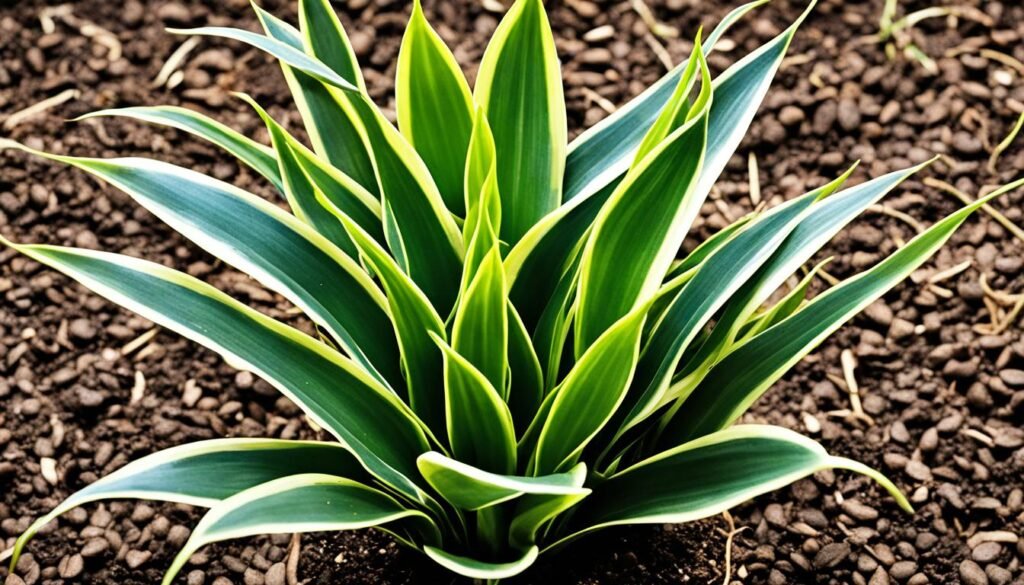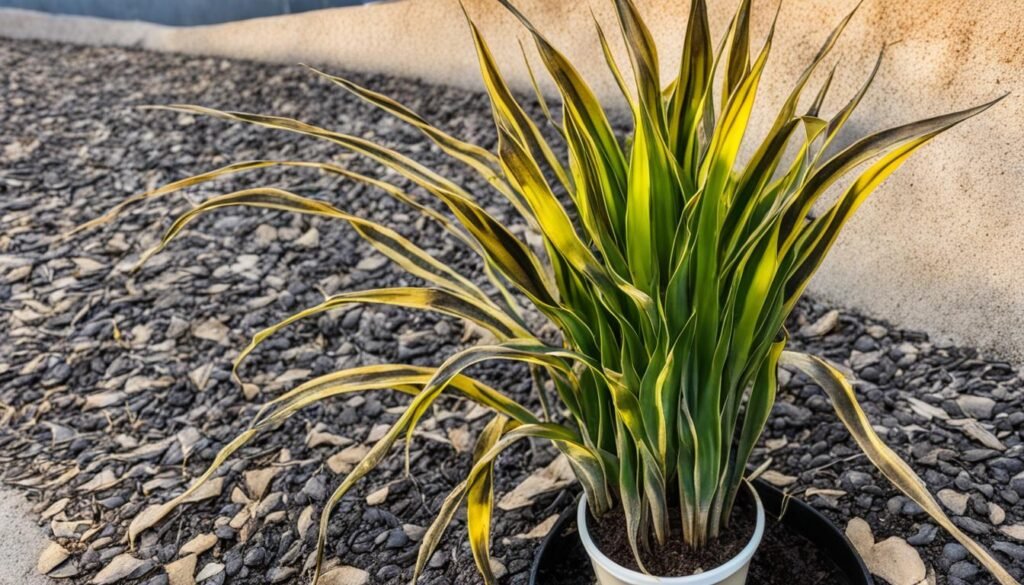Are you looking to ensure the health and vitality of your snake plants? One of the key factors to consider is the type of soil mix you use. Using the best soil for snake plants can significantly improve their overall well-being.
Snake plants are known for their resilience and ability to tolerate neglect, making them popular choices for indoor gardening. However, they require a soil mix that promotes proper drainage and aeration to thrive.
The ideal soil mix for snake plants is slightly acidic and neutral, with excellent drainage capabilities. This ensures that water doesn’t accumulate and causes root rot, which can harm the plant’s health. You can help your snake plant survive and thrive by providing the right growing conditions.
When choosing a soil mix for your snake plant, opting for well-draining options is essential. Commercial products such as Miracle-Gro Indoor Potting Mix and FoxFarm Ocean Forest Potting Soil Mix are excellent choices, as they are specially formulated for indoor plants and provide the necessary balance of nutrients and drainage.
If you prefer a more customized approach, you can create your soil mix for snake plants. One recommended recipe includes a mix of organic potting soil, succulent soil mix, and compost. Another recipe suggests combining regular potting soil, coarse sand, perlite or pumice, and coco coir or peat moss. These homemade mixes allow you to tailor the soil composition to your snake plant’s needs.
Hence, choosing the right soil mix is crucial for maintaining the health and vitality of your snake plants. By selecting a well-draining soil mix or creating your own, you can provide the optimal growing conditions these resilient plants need to thrive. So go ahead and give your snake plants the best soil they deserve!
The Impact of Soil on Plant Health
Soil plays a vital role in determining the health and growth of plants. It provides essential nutrients, water, and oxygen for plants to thrive. The type of soil, its structure, pH level, and fertility significantly impact plant health.
Soil Type
The soil type refers to its physical structure, such as clay, loam, or sand. Different soil types have varying levels of water retention, nutrient availability, and aeration. Clay soil tends to retain water and become compacted, while sandy soil drains quickly and may not hold nutrients. Loam soil is considered ideal as it balances drainage and nutrient retention.
Soil Structure
The structure of the soil determines how well it holds water and organic matter. Crumbly soil with a good structure, rich in organic material, allows for better water absorption, nutrient retention, and root development. This soil type promotes healthy plant growth and provides an ideal environment for beneficial microbial activity.
Soil pH
The pH level of the soil affects nutrient availability to plants. Most plants prefer a slightly acidic soil pH ranging from 5.5 to 7.0. Acidic soil (pH below 7) tends to have more nutrients available for absorption, while alkaline soil (pH above 7) may lead to nutrient deficiencies. Testing the soil’s pH level and adjusting it when necessary can help maintain optimal plant health.
Soil Fertility
Soil fertility refers to the levels of essential nutrients available in the soil. Plants need a balanced supply of macronutrients (nitrogen, phosphorus, and potassium) and micronutrients (iron, zinc, copper, etc.) to grow and thrive. Regularly testing the soil for nutrient deficiencies and supplementing it with organic matter or fertilizers can enhance soil fertility and support plant health.
Soil health directly impacts the overall health and well-being of plants. By understanding and managing soil type, structure, pH, and fertility, you can create an optimal environment for plant growth and ensure the long-term well-being of your plants.
Best Soil For Snake Plant
The best soil for snake plants is crucial to ensure their healthy growth and vitality. These plants thrive in a well-draining soil mix that provides adequate aeration and prevents waterlogging. Two recommended options for the best soil are:
Miracle-Gro Succulent Potting Mix
This soil mix is specially formulated for succulents and cacti, which makes it an excellent choice for snake plants. The Miracle-Gro Succulent Potting Mix combines potting soil, coarse sand, and perlite or pumice. This combination promotes excellent drainage and prevents excess moisture retention, allowing the roots to breathe and preventing the risk of root rot. The optimal soil conditions created by this mix contribute to snake plants’ overall health and well-being.
Perfect Plants Organic Snake Plant Soil
Perfect Plants Organic Snake Plant Soil is another excellent option that provides the ideal conditions for snake plant growth. This coco-coir-based soil ensures proper water flow and prevents waterlogging. The organic composition of the soil allows excess water to flow freely, preventing moisture accumulation that may lead to root rot. By using Perfect Plants Organic Snake Plant Soil, you can create a well-draining environment that supports the development of strong and healthy snake plants.
When selecting the best soil for your snake plants, it is essential to consider factors such as drainage, aeration, and moisture retention. Miracle-Gro Succulent Potting Mix and Perfect Plants Organic Snake Plant Soil offer these qualities, ensuring your snake plants have the optimal growing conditions they need to thrive.

How to Make Your Snake Plant Soil
Making your snake plant soil mix is a cost-effective option that allows you to customize the composition. By creating your soil mix, you control the nutrients, drainage, and aeration specific to your snake plants’ needs. Here are two recipe suggestions to help you make the perfect soil mix for your snake plants:
Recipe 1: Organic Potting Soil, Succulent Soil Mix, and Compost
- Start by mixing three organic potting soil with one succulent soil mix. This combination provides a well-balanced base for your snake plant soil mix.
- Add an equal amount of compost to the mix. Compost enriches the soil with organic matter and adds essential nutrients for healthier plant growth.
This recipe ensures a balance of nutrients and drainage, giving your snake plants the optimal conditions to thrive.
Recipe 2: Regular Potting Soil, Coarse Sand, Perlite or Pumice, and Coco Coir or Peat Moss
- Combine two parts of regular potting soil with one part of coarse sand. The coarse sand improves drainage and prevents the soil from becoming compacted.
- Add one part perlite or pumice to the mix. Perlite and pumice enhance soil aeration and drainage, allowing excess water to flow through effectively.
- Include one part of coco coir or peat moss to retain moisture while maintaining good drainage. Coco coir and peat moss help ensure the soil has enough water for the snake plants without becoming waterlogged.
This homemade soil mix recipe balances nutrients, drainage, and aeration, promoting healthy growth for your snake plants.
Whether you choose Recipe 1 or Recipe 2, making your snake plant soil allows you to tailor the mix to your plant’s specific needs. Experiment with combinations and ratios to find the best soil mix for your snake plants.
Symptoms of a Snake Plant in the Wrong Soil
Using the wrong soil for your snake plant can negatively affect its health. It’s essential to be aware of the symptoms that indicate your snake plant is in unsuitable soil, allowing you to take necessary action to ensure its well-being.
- Slower growth: One of the first signs that your snake plant might struggle in the wrong soil is slow growth. If you notice that your plant is not growing as quickly as it should, it could result from the soil mix lacking proper drainage and aeration.
- Roots getting too wet: Another symptom to watch out for is the roots of your snake plant reaching too wet. If the soil retains too much water, it can cause the roots to become waterlogged, leading to root rot and other health issues.
- Pale leaves: Poor drainage and lack of oxygen in the soil can manifest as pale leaves. If you notice that the leaves of your snake plant are losing their vibrant green color and appearing pale or yellowish, it could indicate that the soil is not providing adequate conditions for the plant to thrive.
- Wilting leaves: Leaves that are wilting and drooping can also indicate that the soil is unsuitable for your snake plant. Excess moisture in the soil can prevent proper oxygen circulation to the roots, causing the leaves to wilt.
If you observe any of these symptoms in your snake plant, switching to a soil mix that provides better drainage and aeration is crucial. This will ensure your snake plant can receive the necessary nutrients and oxygen to grow and thrive.

Using Leca Balls for Snake Plant Soil
Using leca balls, also known as expanded clay, in your snake plant soil can greatly benefit the health and vitality of your plant. Here’s why:
Superior Drainage:
- Leca balls have a porous structure that allows excess water to flow through easily.
- This prevents waterlogging and reduces the risk of root rot, ensuring optimal moisture levels for your snake plant.
Enhanced Aeration:
- The air pockets within leca balls promote proper airflow around the roots, preventing soil compaction.
- This encourages healthy root development and overall plant growth by facilitating oxygen circulation.
Balanced Moisture Regulation:
- Leca balls absorb and release water as needed, helping to regulate moisture levels in the soil.
- This ensures your snake plant receives adequate hydration without becoming oversaturated, promoting overall plant health.
Easy Incorporation:
- Mixing leca balls with your preferred potting soil or other components creates a well-balanced growing medium.
- Aim for a ratio of approximately 30-50% leca balls in the soil mixture to provide optimal benefits.
By incorporating leca balls into your snake plant soil, you can create an environment conducive to healthy growth and thriving. With improved drainage, enhanced aeration, and balanced moisture regulation, your snake plant will receive the care it deserves, leading to robust root development and vibrant foliage. Give your plant the best possible growing conditions with the help of leca balls.
Conclusion
Providing the optimal soil mix is crucial for snake plants’ healthy growth and care. For snake plants, it is essential to use a well-draining soil mix that allows for proper aeration and drainage. The ideal soil composition includes potting soil or cactus mix, perlite or pumice, coarse sand, and optional amendments such as peat moss or coconut coir.
Various options for snake plant soil are available, including commercial ones like Miracle-Gro Succulent Potting Mix and Perfect Plants Organic Snake Plant Soil. These soil mixes are specifically formulated to provide healthy snake plant growth conditions, ensuring the soil retains adequate moisture without becoming waterlogged.
Proper care also involves monitoring the soil’s moisture levels, avoiding overwatering, and maintaining the optimal pH range of 5.5 to 7.5 for snake plants. With suitable soil, snake plants can thrive and add a touch of beauty to any indoor space. So, remember to choose the optimal soil mix for your snake plants to ensure their health and vitality.
FAQ
What kind of soil is best for snake plants?
Snake plants thrive in slightly acidic to neutral soil that is well-draining. It is essential to choose a soil mix that is light, airy, and does not retain water.
What are some recommended soil options for snake plants?
Recommended soil options for snake plants include Miracle-Gro Indoor Potting Mix and FoxFarm Ocean Forest Potting Soil Mix.
Can I create my soil mix for snake plants?
Yes, you can create your soil mix for snake plants. One recipe suggests a mix of organic potting soil, succulent soil mix, and compost, while another recommends a mix of regular potting soil, coarse sand, perlite or pumice, and coco coir or peat moss.
What are the signs that my snake plant is in the wrong soil?
Signs that your snake plant is in the wrong soil include slower growth, wet roots, pale leaves, and wilting leaves.
Can I use leca balls in snake plant soil?
Yes, leca balls are a great option for snake plant soil. They provide excellent drainage aeration and help prevent root rot.
How do I ensure the health and growth of my snake plant?
To ensure the health and growth of your snake plant, use a well-draining soil mix that provides proper aeration and drainage. Monitor the soil’s moisture levels, avoid overwatering, and maintain the appropriate pH range of 5.5 to 7.5 for snake plants.
Author
-

Anne Williams is a passionate wordsmith, blending creativity with expertise in SEO to craft captivating content. With a penchant for concise yet compelling prose, she brings stories to life and leaves readers craving more. When she's not penning her next masterpiece, you can find her exploring new coffee shops or lost in the pages of a good book.
View all posts






